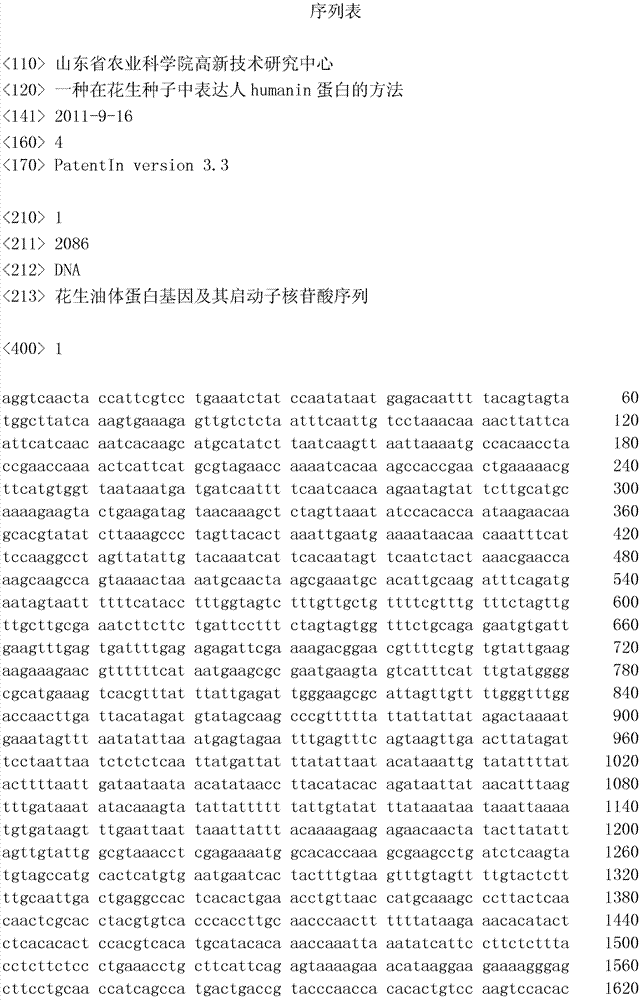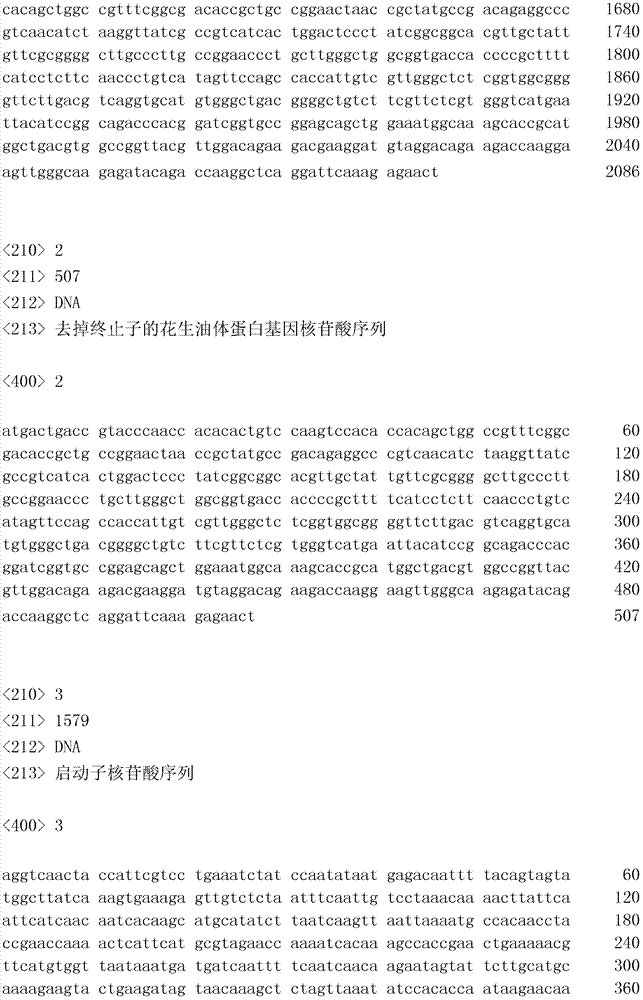Method for expressing human humanin protein in peanut seed
A peanut and protein technology, applied in the field of expressing human humanin protein, to achieve the effect of increasing added value, low cost and convenient transportation
- Summary
- Abstract
- Description
- Claims
- Application Information
AI Technical Summary
Problems solved by technology
Method used
Image
Examples
Embodiment 1
[0035] Example 1 Cloning of the peanut oleosin gene comprising a promoter
[0036] According to the sequence of the promoter and coding gene of peanut oil body protein in Genbank (gene accession number: EF695400), design forward primer primer1 containing EcoRI restriction site (GAATTC): AGAAT TCAGG TCAAC TACCA TTCGT; According to the sequence of peanut oil body protein gene Open reading frame sequence, remove stop codon, design reverse primer primer2 with KpnI restriction site (GGTACC): GGTACCAGTTCTCTTTGAATCCTG.
[0037] Extract the genomic DNA of peanut (Luhua 14), the method is as follows:
[0038] (1) Take 1 g of young peanut leaves, grind them into powder with liquid nitrogen, and place them in an Eppendof tube pre-cooled by liquid nitrogen;
[0039] (2) Preheat CTAB extract (2% CTAB, 1.4mol / L NaCl, 20mmo / L EDTA (pH8.0), 100mmol / L Tris-Cl (pH8.0), 2% pvp- 40);
[0040] (3) To estimate the mass of the sample tissue, add 700 μL of preheated CTAB extract to each 200 mg sam...
Embodiment 2
[0056] Synthesis of embodiment 2 people's Humanin gene
[0057] According to the humanin gene (NP_001177635) sequence in Genbank, two partially complementary single-stranded DNA primers were designed and synthesized, in which the forward primer contained KpnI (GGTACC) site and enteropeptidase recognition sequence (GATGATGATGATAAG) primer3: GAAGGTACCG ATGATGATGA TAAGATGGCT CCACGAGGGT TCAGCTGTCT CTTACTTTTA ACCAGTGAAA TTGACCTGCC; the reverse primer contains His tag sequence (CACCAC CACCAC CACCAC) and SalI restriction site (GTCGAC) primer4: ACGCGTCGAC TTAGTGGTGG TGGTGGTGGT GTGCCCGCCT CTTCACGGGC AGGTCAATTT CACTGGTTAA AAGTAAGAGA.
[0058] Use TAQ enzyme for annealing and extension, primer3 (100 μM) 1 μl, primer4 (100 μM) 1 μl, the program is: 94 ° C for 3 min; 40 ° C for 1 min; 72 ° C for 2 min; store the product at 16 ° C; the product is electrophoresed on 1% agarose gel, Observe the results under ultraviolet light, recover the target band from the gel, connect the recovered produc...
Embodiment 3
[0059] The construction of embodiment 3 plant expression vectors
[0060] The construction process of plant expression vector is as follows: figure 1 Shown:
[0061] (1) Connect the peanut oleosin promoter and ORF to the pCAMBIA2300-35S-OCS plant expression vector. The plant expression vector backbone comes from Cambia Company and is transformed by the Institute of Genetics and Developmental Biology, Chinese Academy of Sciences (Luo et al.Journal of Integrative plant biology, 2005, 47(6), 745-752): pCAMBIA2300-35S-OCS plasmid and T-AhOleosin plasmid were digested with EcoRI and KpnI respectively, the vector sequence and AhOleosin sequence were recovered, and the two were combined with T4DNA ligase. Ligation: 1 μl of 10×T4D NA ligase buffer, 6 μl of AhOleosin, 2 μl of pCAMBIA2300, 1 μl of T4 DNA ligase, ligation overnight at 16°C, the ligation product was transformed into E. coli DH5α according to the method in Example 1, and verified by double enzyme digestion with EcoRI and ...
PUM
 Login to View More
Login to View More Abstract
Description
Claims
Application Information
 Login to View More
Login to View More - R&D
- Intellectual Property
- Life Sciences
- Materials
- Tech Scout
- Unparalleled Data Quality
- Higher Quality Content
- 60% Fewer Hallucinations
Browse by: Latest US Patents, China's latest patents, Technical Efficacy Thesaurus, Application Domain, Technology Topic, Popular Technical Reports.
© 2025 PatSnap. All rights reserved.Legal|Privacy policy|Modern Slavery Act Transparency Statement|Sitemap|About US| Contact US: help@patsnap.com



